A pull-down and pull-out faucet is ideal for any homeowner seeking an all-in-one faucet. To get the best faucet, you must look beyond cost and style.
It concerns your sink size, space, convenience, and overall functionality.
According to Fortune Business Insights research, the global market size for pull-down and pull-out kitchen faucets was US$ 1,990.6 million in 2018. The same is projected to rise to US$ 2,954.3 million by 2026.

Source: Fortune Business Insights
This research further projects that there will be a huge demand and market growth for pull-out and pull-down kitchen faucets in the future. This is because of the emergence of smart homes globally and many people willing to incorporate smart home technology in their existing households.
There exist several differences and similarities between these two faucets. In this article, we’ll walk you through both types in depth, showing you their strengths, drawbacks, and differences in features.
JUMP TO: Table of Comparision | About Pull Down Faucet | About Pull Out Faucet | Differences Between Pull Down &n Pull Out Faucet |
- Pull-down faucets work best for deep, more expansive sinks, while pull-out faucets go well with shallow sinks.
- The pull-out faucet’s hose is longer than that of the pull-down faucet
- Pull-down faucets are available in various unique and beautiful designs, unlike pull-out faucets.
- Pull-out faucets save on space more than pull-down faucets.
Quick Overview (Table Comparison)
| PARAMETER | PULL DOWN FAUCET | PULL OUT FAUCET |
| Height | Tall | Short |
| Size of the spout | Longer spout | Shorter spout |
| Faucet head | High-arc faucet head | Low-arc faucet head |
| Application (shallow or deep sinks) | Ideal for deep sinks | Ideal for shallow sinks |
| Ease of spray control | Easier spray control | Not-so-easy spray control |
| Water pressure | Low water pressure | Adequate water pressure |
| Saving on space | It does not save on space | Saves on overhead space |
| Style and design options | Varieties of unique styles and design options | Most of the styles and design options have similar features |
| Ergonomic friendliness | Ergonomically friendlier | Less ergonomically friendlier |
Pull Down Faucet – Explained
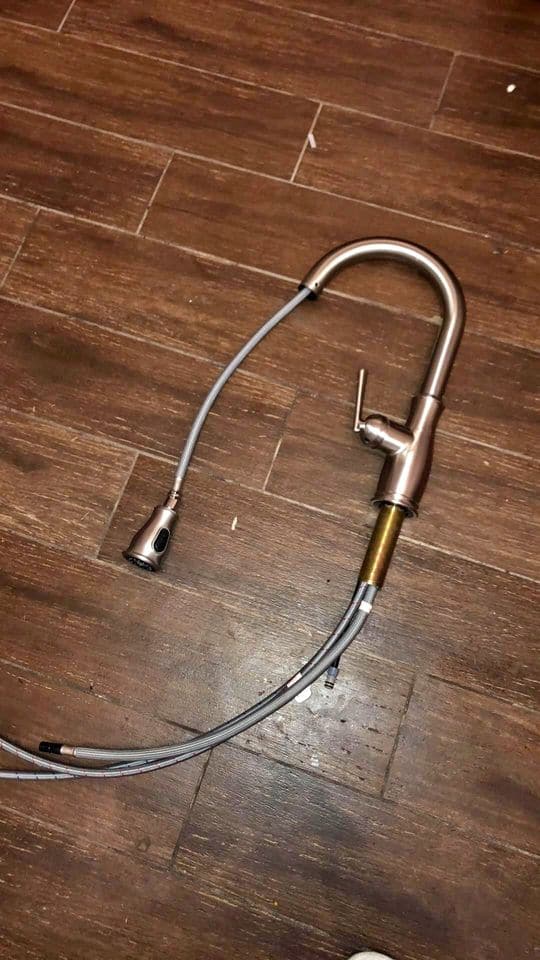
Pull-down faucets are also known as “gooseneck” because of their high-arc shape. Their height creates an elegant focal point in the space.
Most of these faucets have either rustic or industrial details in their designs. As such, they are compatible with many kitchen styles, finishes, and décor.
The pull-down design allows you to stretch the spout downwards, making it easy to use as a manual hand sprayer.
Pros
Allows more control: Pull-down faucets come with various spouts and spraying patterns to suit the functionalities of different users.
Longevity: The hose of a pull-down faucet takes fewer movements and limited twisting to use. Therefore, it can last longer before breaking down. But if you want your faucet to last longer, consider purchasing a high-quality one.
Versatility: This faucet is available in different styles and finishes.
Cons
Less water pressure: The water pressure from a pull-down faucet is lower than that of a pull-out model because of the taller spout.
Not suitable for smaller sink spaces: A pull-down faucet can cause unwanted splashing outside the sink if you have a shallow kitchen sink.
Related Read: Chrome Vs. Stainless Steel Faucets
Pull Out Faucet – Explained
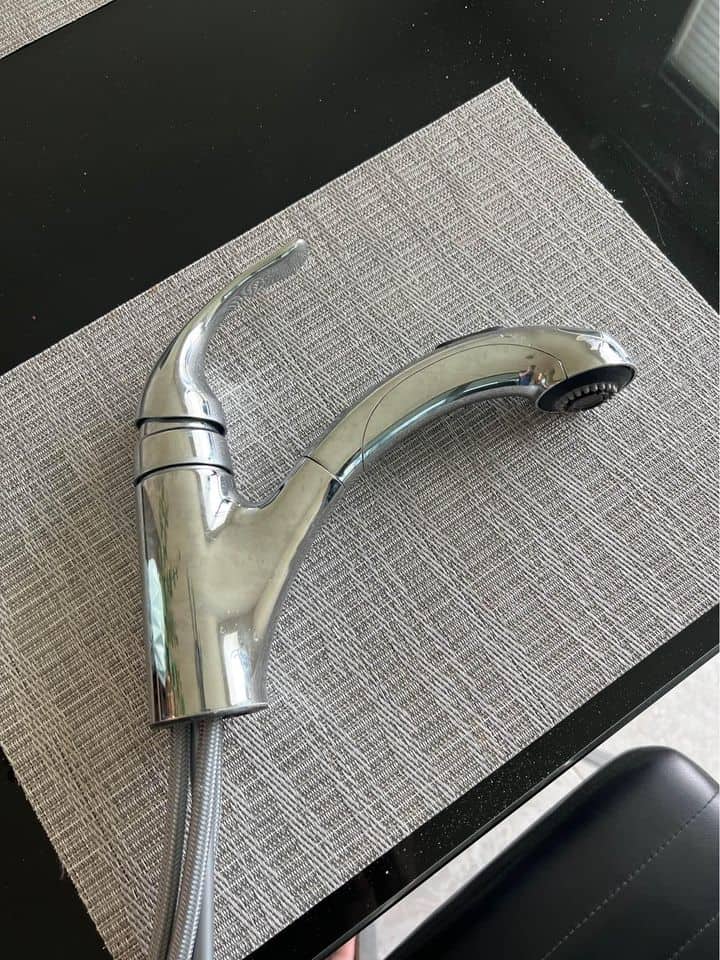
A pull-out kitchen faucet resembles a deck-mounted tap. It has less headroom, thus ideal for kitchen cabinets above the sink.
A pull-out faucet’s spray head is smaller than a pull-down faucet’s. So, there is less likelihood of heavy splashing even when used on a shallower sink.
A pull-out faucet works by literally “pulling out” the spray head out of the faucet body. It can turn 180 or 360 degrees. The spout points to the sink’s center when stationary.
Pros
Economical on space: A pull-out faucet has a shorter spout, leaving enough room overhead for additional storage.
Flexibility: A pull-out faucet has a more flexible, ergonomic design. It features a longer hose which is convenient when filling pots far from the sink area.
Less splash-back: This faucet works well for small and shallow sinks as it does not cause too much splashing.
Cons
Low-arc: Many people find pull-out sinks less effective for filling pots or rinsing dishes.
Limited designs: There are few unique designs of pull-out faucets compared to pull-down models in the market. Besides, pull-out models have a more traditional look.
9 Crucial Differences Between Pull-Out and Pull-Down Facets
Here are nine significant differences in the pull-down and pull-out kitchen faucet features.
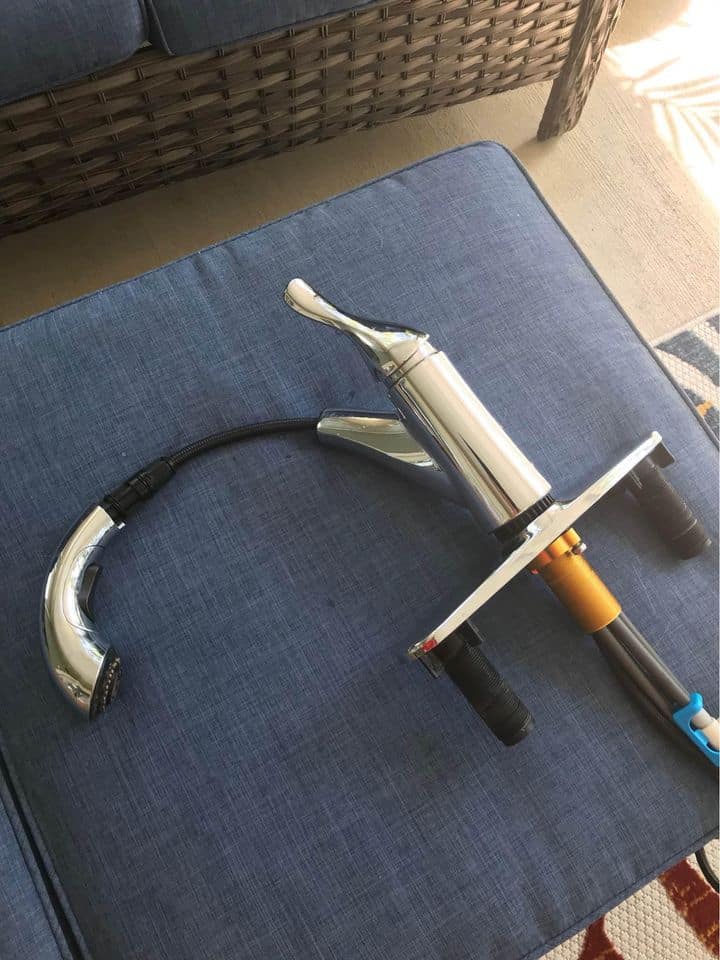
Height
A pull-down kitchen faucet is taller in design and appearance, while a pull-out faucet is shorter. But when it comes to the hose length, a pull-out faucet has a longer hose than a pull-down faucet.
Verdict: The pull-down faucet is the winner. Its tall and elegant design makes a statement in every kitchen.
Size of the Spout
A pull-down faucet has a taller spout and works best for big-sized sinks. It’s an excellent option to clean and fill taller pots.
A pull-out faucet features a shorter spout and is best suited for a small or mid-sized sink.
Verdict: The pull-down faucet is the winner. It has a longer spout which is practical in most modern kitchens.
Faucet Head
The size and shape of a faucet head are significant considerations when deciding between a pull-down and a pull-out kitchen faucet. The two offer different functions, so you must be sure which works best for you.
A pull-down faucet head has a high arc. It is, therefore, ideal for large kitchen sinks that don’t have overhead storage.
On the other hand, a pull-out faucet head is an excellent choice if your sink area is smaller or you have above-the-sink cabinetry.
Verdict: This feature has a tie because both faucet heads are significant, depending on the size of your sink.
Application (shallow or deep sinks)
A pull-down faucet stretches downwards, thus ideal for deep sinks. This kind of faucet is prone to splashing because of its high arc. As such, it is advisable not to use it on a shallow sink.
A pull-out faucet is recommended for use in shallow sinks as it has a shorter spout and less splashing.
Verdict: Both faucets tie on this feature because your sink’s type will determine which one is best for you.
Also Read: 16 Types of Kitchen Faucets Explained
Ease of Spray Control
How well does the spray button work on your pull-down or pull-out faucet?
Ensure you test the button before purchasing any faucet to determine your overall satisfaction.
Also, consider the ease of switching between spray modes. For some faucets, the spray button clicks like a switch, while you’ll need to push the button for others.
Another consideration is; the number of modes available in that particular model.
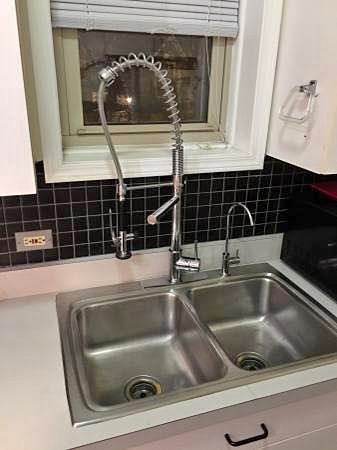
Pull-down faucets often have more pressure options and spray types. Others even give you the option of widening or narrowing the spray stream.
Moreover, the spray button on a pull-down faucet is easily accessible, and switching spray modes is straightforward.
Verdict: The pull-down faucet is the winner. It has easier spray control than its counterpart.
Water Pressure
The tall spout of a pull-down faucet can limit its water pressure. Also, these faucets tend to perform poorly in situations where the general water pressure in the home is low.
Pull-out faucets work well without hindrances of water pressure. In fact, they have just the correct water pressure plus a longer hose to reach the areas on the counter.
You can fill a pot on the counter without clearing the sink to rest it.
According to the American Water Works Association, the average water pressure from a kitchen faucet should be 1.54 gallons per minute.
Verdict: The pull-out faucet is the winner. You are unlikely to encounter any issues with low water pressure when using this faucet.
Saving On Space
Pull-down faucets have longer spouts which require more overhead space.
On the other hand, pull-out faucets are excellent for saving space. They have shorter spouts and are suitable for kitchens that have smaller sink spaces. They are also great if you have cabinets above the sink area.
Verdict: Pull-out faucets are the winners as they save so much space.
Style and Design Options
A pull-down model could be your best bet if you are looking for a unique, exotic kitchen faucet. Each of these faucets has outstanding features that distinguish it from the rest.
Although there are plenty of styles and design options for pull-out faucets, you’ll find minimal variation from one model to the other.
Verdict: A pull-down faucet takes the lead here. It has an array of unique styles and design options.
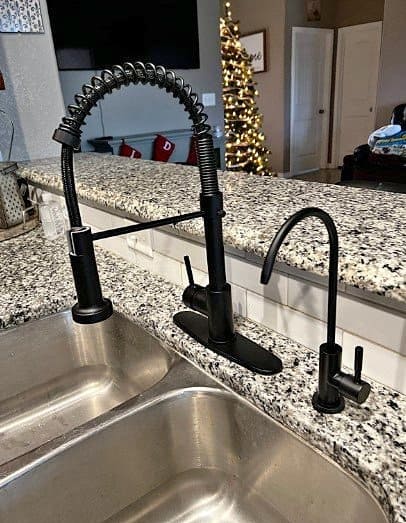
Ergonomic Friendliness
The pulling motion used to operate a pull-down faucet is ergonomically friendlier than a pull-out faucet. You only need to pull the spray wand out and down in one fluid motion. This requires less movement and maneuvering of the wand.
The pull-out option requires you to somehow detach the spray wand from the faucet while in use. Although most people don’t consider this feature a deal-breaker, it is less ergonomic than a pull-down option.
Verdict: The pull-down faucet is the winner here. It is more comfortable, ergonomically correct, and easier to use.
Related Read: Kitchen Faucet Vs. Bar Faucet
Wrapping it up
The best kitchen faucet for you narrows down to your sink space and personal preference.
A pull-down faucet could be a good choice if you have a deep and spacious sink room. And if you have a constrained sink space, shallow sink, or overhead cabinetry, you can consider a pull-out faucet.
Besides that, there are other factors to consider, as detailed in this comparison. I hope this helps you make the correct choice.
![Kitchen Faucet Vs. Bar Faucet [What is The Difference] Kitchen Faucet Vs. Bar Faucet [What is The Difference]](https://houseadorable.com/wp-content/uploads/2023/01/GettyImages-1177440335-0210e69740fd4045ab6a88f1588e9f4f.jpg)
![Centerset Vs. Widespread Faucets [8 Differences Explained] Centerset Vs. Widespread Faucets [8 Differences Explained]](https://houseadorable.com/wp-content/uploads/2023/03/1_332369605_6500081363358836_8480186754416832788_n-250x250.jpg)
![16 Types of Kitchen Faucets Explained [With Pros + Cons] 16 Types of Kitchen Faucets Explained [With Pros + Cons]](https://houseadorable.com/wp-content/uploads/2023/02/Roca_griferia_cocina_mencia_negro_DEF_900x505_acf_cropped-1@2x-250x250.jpg)
![Granite Vs. Marble Vs. Quartz Countertops [12 Differences+Pros & Cons] Granite Vs. Marble Vs. Quartz Countertops [12 Differences+Pros & Cons]](https://houseadorable.com/wp-content/uploads/2022/03/quartz-marble.jpg)
![Chrome Vs. Stainless Steel Faucets: [An In-Depth Analysis] Chrome Vs. Stainless Steel Faucets: [An In-Depth Analysis]](https://houseadorable.com/wp-content/uploads/2023/03/51gDGcVWBL._AC_UF10001000_QL80_-250x250.jpg)
![Pros and Cons of Wall-Mounted Faucets : [Includes Buying Guide] Pros and Cons of Wall-Mounted Faucets : [Includes Buying Guide]](https://houseadorable.com/wp-content/uploads/2023/02/s-l1600-250x250.jpg)
![Ceramic vs Stainless Steel Sink [A Detailed Analysis] Ceramic vs Stainless Steel Sink [A Detailed Analysis]](https://houseadorable.com/wp-content/uploads/2021/12/Ceramic-vs-ss.jpg)
![How Much Does It Cost to Build a Kitchen Island? [Custom Made+DIY] How Much Does It Cost to Build a Kitchen Island? [Custom Made+DIY]](https://houseadorable.com/wp-content/uploads/2022/03/cost-of-kitchen-island.jpg)